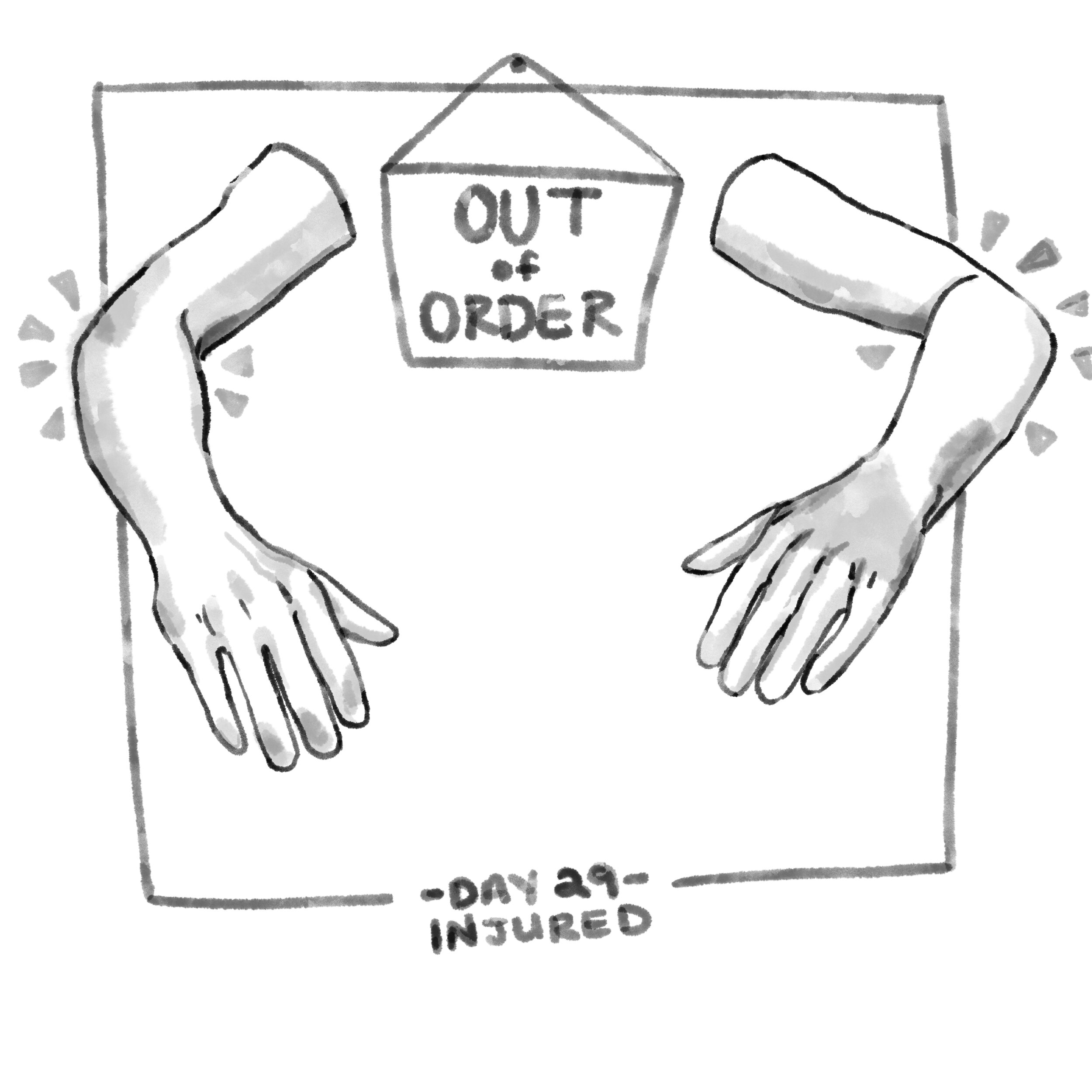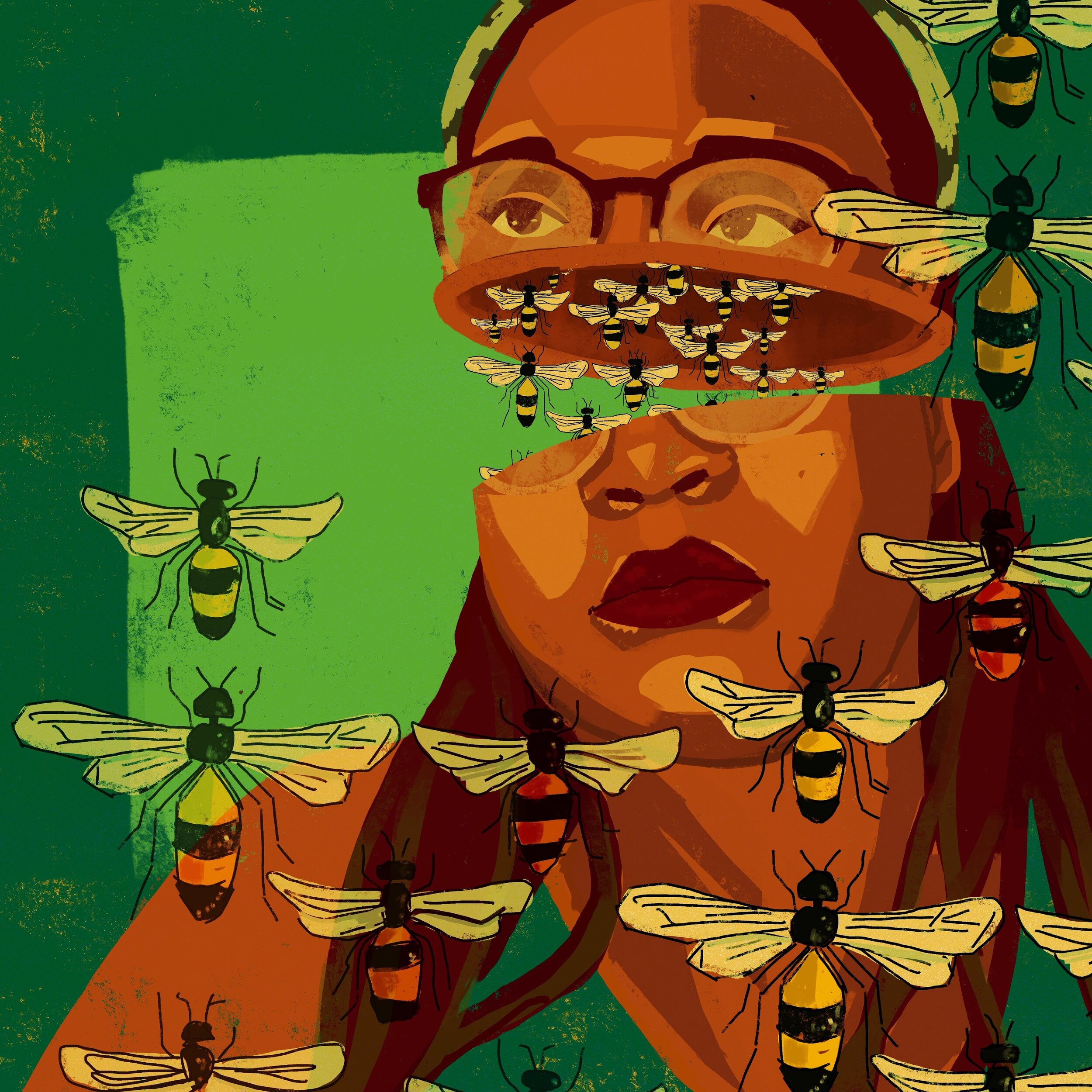Quilted Lady
Marilyn Holmes
“I think story, in terms of just being human, is so incredibly important.”
Interview by L. Valena
Can you first tell me what you responded to?
I responded to a series of images of a woman wearing parts of a quilt or parts of clothing. She was standing very deliberately outside of a window. As the photos continued, she got closer and closer to the window, until she was right up on it. There was kind of a sense of dread with her coming closer, which I found really interesting. You couldn’t see much of her face. It made me think of a fairy tale, a character in a story, something you would imagine coming out of darkness, out of shadow. Even though the photos themselves were very bright.
What happened next? Where did you go from there?
When I was creating my own artistic response, I think that made me go with a more illustrative style. Thinking of children’s storybooks, or animations. I was really attracted to all of the different patterns of the fabrics that made up her dress and hood, so I wanted to include those in my artwork. I also wanted to keep a soft, expressive style, because I thought that it would fit the mood the best.
Can you talk more about the piece that you made?
I made a digital illustration using Procreate- that’s how I do most of my artmaking. I ended up creating a figure coming out of darkness. I gave her a lantern, because I figured she needed to see where she was going, even if maybe it couldn’t be perceived by others. I wanted to create a Babayaga or witch-like creature, coming out of the darkness and going where she pleases. Kind of playing off that sense of dread, but also thinking about it from her perspective. Overall, I thought it was a very powerful series of images, and I wanted to continue that powerful feeling.
How does this relate to the rest of your work?
I think it relates to the rest of my work kind of peripherally. I don’t fall into an illustrative style very often these days. Most of the commission work I’ve been doing has been photorealism or portraiture, things like that. This was me going back to the work I used to make when I was an undergrad and in highschool, when I wanted to be an illustrator.
I think telling stories is such an incredible part of artmaking, and why artmaking is so important. To be able to add images to stories, and make visible what we’re all kind of imagining. I think that’s an incredibly important part of an artist’s role. For me, it felt good to go back to that- it felt like going back to my artmaking roots, what made me want to be an artist from the beginning. I’m an art therapist, so story and artmaking go hand in hand. A lot of the clients that I work with are literally transcribing or creating their stories in artistic form as a form of therapy. There’s something that feels powerful in doing it for myself.
What was it like doing this exercise as an art therapist?
It’s always interesting. I think I attach more emotion to my artmaking now than I did prior to my art therapy training. I don’t always mean to, I think it just happens naturally now, because I kind of think, “if the artist was my client, what would they be trying to say through this artwork?” That’s not always the best method, but I think it just kind of happens in my brain naturally, the way it works now. So, what would this woman represent for someone in a therapy space? What would this image represent to someone? What would the patterns on her clothing represent? Are they pulled from childhood? All of those things that run through what would go in a relationship between myself and the client, became the relationship between me and the art that I was doing. I think that being an art therapist changes the questions I ask, and how I ask them.
I think that ties in so nicely with what you said earlier about art and story!
Yeah! I think it’s so critical. It’s a critical part of the work I do, both as an artist and as an art therapist, but I think even more so as an art therapist. I work with a lot of victims of sexual assault and domestic violence, and a lot of people who have experienced substance abuse. With trauma and substance abuse, memory can become very fragmented. Someone who has trouble recalling what happened to them often wonders, “What is real? What is fake? What is fiction? What is my mind trying to protect me from? What actually happened that I can’t accept?”
Creating narrative artwork for them has become a pretty awesome treatment, because it gives them control over their story. Sometimes if we’re writing or making art about it, we’re acknowledging that this may not actually be what happened, but this needs to be what we think happened in order to protect ourselves. And that’s okay.
I was reading Waking The Tiger by Peter Levine, and he notes that memory is not a film reel. Memory is more like a collage. It is made up of pieces of newspaper, fragments of images, things that we’re just trying to put together and glue over and make sense of. If it makes sense, that’s okay, and sometimes that’s what we need in the moment. Giving people ways to take control of their own stories has been one of the most powerful things I’ve been able to do as an art therapist. Sometimes having your abuser gaslight you they are trying to take your narrative away from you. Being able to book-make, and have a journal that’s a concrete record that says, “this is what happened, this is what I remember, I know this is what happened,” can be a powerful counteragent for that.
I’ve worked with teenagers making zines, or little graphic novels, just so they have this tangible thing to hold on to. “I know what happened, I know my memory is not failing me, and this is the truth.” Even if everyone around them is saying that it’s not what happened. I think story, in terms of just being human, is so incredibly important. It gives us that sense of control, and allows us to exert ourselves and our existence. We acknowledge that we’re here, and we go through things, even if other people minimize the things we go through.
It felt good to get back into artmaking just to make art, rather than for a therapeutic sense. Being given a prompt is sometimes more helpful than just flying off my head, digging around in there and trying to find something to make art about. I appreciated that. “Here’s this prompt, here’s two weeks, figure out what you’re going to do!” This was extremely helpful, I might need to find a way to do this in my own way- keep myself making art.
Do you have any advice for another artist who’s about to respond to a prompt like this?
I would say to just go with it. That first thought that pops into your head, just go with it. Don’t think too hard, just let it be what it’s gonna be. I feel like sometimes I get wrapped up in my head, and take so much time planning that I don’t actually make the artwork. It felt good to just go with it.
Call Number: M32NA | M33VA.hoQu
Marilyn Holmes is an artist and art therapist originally from Louisville, KY. While she currently works as an outpatient counselor and art therapist in southern Illinois, she still enjoys the opportunity to work as a digital illustrator from time to time.




